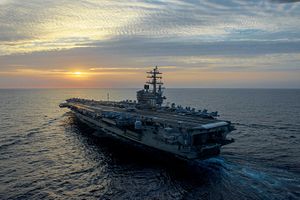The U.S. Navy and Republic of Korea Navy (ROKN) will kick off a major naval exercise in the waters off the Korean Peninsula on October 17 involving a U.S. carrier strike group, according to a U.S. 7th Fleet statement.
The so-called Maritime Counter Special Operations exercise (MCSOFEX) will last from October 17-20 and “promote communications, interoperability, and partnership in the 7th Fleet area of operations,” the statement reads.
“The exercise will provide a visible and coordinated engagement for the U.S.-ROK alliance. It will also conduct combined joint operations and exercises with ROK Navy, U.S. Seventh Fleet, ROK Air Force, U.S. Pacific Air Forces’ 7th Air Force and U.S. Eighth Army for the purpose of continuing the United States’ national policy and commitment to the U.S. – ROK alliance and the region.”
The drill involves the Arleigh Burke-class guided missile destroyers USS Stethem and USS Mustin, as well as the nuclear-powered Nimitz-class aircraft carrier USS Ronald Reagan. (The USS Ronald Reagan, the U.S. Navy’s only forward deployed carrier in the Asia-Pacific region homeported at Yokosuka Naval Base in Japan, resumed operations this May after a long in-port maintenance period.)
“The carrier’s escort includes the Ticonderoga-class guided-missile cruiser USS Shiloh; the Arleigh Burke-class guided-missile destroyers USS Barry, USS John S. McCain, USS McCampbell and USS Mustin,” I explained in May. “Every carrier strike group (CSG) is also accompanied by one or two nuclear-powered fast attack submarines.”
The ROKN will participate with KDX-III Sejong the Great-class multi-purpose destroyers, fitted with the Aegis combat system, next to other defense assets including military aircraft. Three Sejong the Great-class warships are slated to be upgraded with the latest Aegis variant, which will enable the destroyer to better share threat data with U.S. and Japan Maritime Self Defense Force (JMSDF) combatants of North Korean missile launches, among other things.
A total of 40 vessels are expecting to participate in the drill.
In a statement, the ROKN said that the purpose of the drill is to “prepare for maritime provocations by North Korea and improve the ability to implement combined operations,” NK News reports.
“The ROKN said the allies would seek to boost their capability to carry out concerted and combined operations through anti-submarine warfare (ASW), missile alert drills, maritime interdiction operations (MIOs), and air defense operations, among others.”
Senior ROKN leadership emphasized that the naval exercise is a regularly-scheduled event. “The training is a regular combined one to prepare for the threat of various maritime provocations by North Korea and to strengthen interoperability between the South and the U.S.,” Vice Admiral Jung Jin-sup, ROK chief of naval operations, said.
According to Yonhap news agency, participants also include a unit of U.S. special forces tasked with carrying out “decapitation” stationed aboard a nuclear-powered submarine. The U.S. Navy Los Angeles-class attack submarine USS Tucson and the Ohio-class guided missile submarine USS Michigan arrived in South Korea last week.
U.S. and ROK naval forces also kicked off a separate naval drill this week to enhance mine countermeasure coordination. The so-called Multinational Mine Warfare Exercise (MN MIWEX) began on October 15 and will last all week.
“Over the next week, mine countermeasure ships, aircraft and explosive ordnance personnel will conduct a series of drills meant to practice procedures and tactics to detect and neutralize sea mines in order to create safe navigation routes in a given area of operations,” according to an October 16 U.S. Navy statement. “The evolutions are meant to provide increased mine countermeasure interoperability and readiness to respond to a contingency on the Korean peninsula.”

































